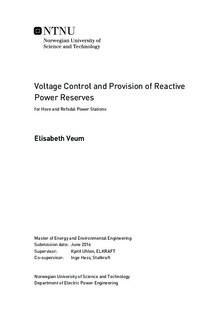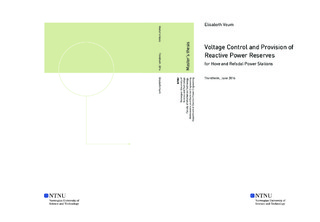| dc.description.abstract | In this thesis voltage control and provision of reactive power reserves were studied, for multiple generators connected to a common main transformer. The system that was considered consists of two power stations in Vik in Sogn, Hove and Refsdal, which are operated by Statkraft. Each of the power stations has two generators that are connected to the grid through a common transformer. In this thesis voltage control and reactive power should be analyzed, in an attempt to come up with suggestions to how voltage control of paralleled generators might be done. How the AVR's tuning of reactive droop and compensation would affect a power system with generators operating in parallel, and how utilizing different measuring points would affect the regulation, should also be investigated. The voltage drop across the transformers was also considered. In addition, the principles of the current strategy for control were discussed and tested, and Statnett's requirements regarding voltage control and provision of reactive power reserves were evaluated. To perform the different simulations, a simplified model of the actual system was made in the simulation programme DIgSILENT PowerFactory, and various functionalities in the programme were utilized.
It should be mentioned that the voltage at both the generators' terminals and the transformer's grid side should be taken into account when investigating voltage control. It will not be sufficient to only consider the voltage at the terminals, as the transformer reactance will introduce some voltage drop. As a net droop is required on the generators' terminals in order to secure stable operation of paralleled generators, as was proved in the simulations, and the transformer reactance provides some voltage drop, the resulting droop at the transformer's grid side will be a result of both the droop settings as well as the transformer reactance. Hence, the transformer reactance limits how small the resulting droop at the grid side could be.
When studying the voltage drop across the transformers, it was for this system found that the voltage variations at the generators' terminals, and the voltage drop across the transformers, were mainly related to the change in reactive power. The voltage variations were almost unaffected by the active power supply.
The simulations investigating the effect of utilizing measurements from the transformer's grid side showed that there were no clear advantages by using this strategy. The stability was not improved, and the variations in voltage and reactive power remained equally large compared to the case when the measurements were taken from the generators' terminals. It was also found that there could not be a net compensation at the terminals of the paralleled generators, regardless of what measuring points were utilized. Hence, compensation could not be utilized in order to obtain a constant voltage at the transformer's grid side, when operating multiple generators connected to a common transformer. Consequently, a net droop must be applied at the generators for such cases, as mentioned above.
The investigation of the AVR's tuning of reactive droop and compensation for one generator operating alone, showed that the generators might be able to contribute to improve the overall voltage control in the system. For a single operated generator compensation could be applied, and hence a more constant voltage might be obtained at the transformer's secondary side, dependent on the grid in which the generator is connected.
The simulations investigating tuning of the AVRs, with respect to various voltage intervals, showed that the droop settings should be adjusted to suitable voltage ranges in order to improve the regulation. In today's system, the droop at the generators in Hove and Refsdal is of 5% and 10% respectively. But when considering the control procedure utilized, adjusting the reactive set point, the resulting droop at the secondary side is of about 33% in Hove and 38% in Refsdal. These droops are large, and the generators would consequently not provide much of a contribution to voltage and reactive power control. In order to obtain a better tuning of the AVRs, the power producer must first determine what voltage variations the droop should be adjusted to. If the power producer wants to avoid changing the set point for voltage or reactive power, even when large voltage variations are considered, a large droop is needed. On the other hand, if a smaller voltage range is considered, a larger contribution to voltage and reactive power control could be given if the droop is reduced. As mentioned above, the resulting droop on the grid side will be dependent on both the droop at the generators and the transformer voltage drop.
It should also be mentioned that Statnett's requirements for voltage control and provision of reactive power reserves might be difficult for the power producers to meet, when operating paralleled generators. The simulations and analytical evaluations indicated that the resulting droop at the transformers' grid side were larger than what was found considering these requirements, due to the transformer reactance. In order to meet Statnett's demands the power producers operating paralleled generators might have to utilize control strategies that adjusts the AVR's set points, e.g. through a secondary control loop. Still, Statnett's requirements regarding voltage and reactive power control, and the cooperation between Statnett and the power producers, should be studied further, in order to approach the challenges related to the overall voltage control and system support of reactive power. | |

